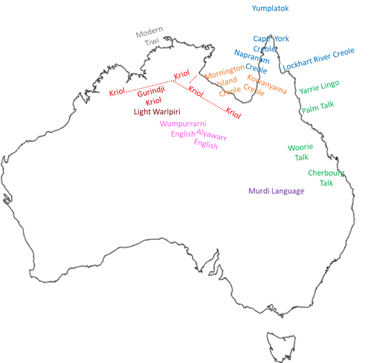Mapping Indigenous languages
- Working with children who speak Indigenous languages/dialects
- Partnering with family and community
- Working with children’s first language(s)
- Understanding the local context
- The impact of Australia’s history on Indigenous languages
- Resources
- Building on Indigenous children’s strengths
- Which Indigenous languages are spoken where?
- Mapping Indigenous languages
- Traditional languages
- New contact languages
- Englishes
- What is a dialect?
- How children learn Standard Australian English as an additional language or dialect
- A day in the life of …
- The difference between language and literacy learning
- The role of language in learning
- Bilingual schools
- Setting up for success
Through the Language Zone, you will find the abbreviations L1 and L2. L1 refers to the first language that a person speaks. L2 refers to the second or additional language that they acquire.
Maps
Map of Heartlands of traditional languages with more than 1000 speakers (in NILR, Figure 1.2, reproduced from Macquarie Atlas).

'Nine traditional Australian languages with 1000 or more speakers, 2016'
Map showing where children acquire ‘Traditional’ Languages as L1 (first language) or L2 (second or additional language) (WILE p. 15; also NILR).

The map is an estimation of where ‘traditional’ and ‘new’ Indigenous languages are acquired by many children as first or second languages, extrapolating from data sources including the 2016 ABS census. It is a broad-brush picture of language ecologies in Indigenous Australia, e.g., the complexity of language use in towns is not represented. The category Traditional languages acquired as a second or additional language (L2) includes areas for which there is little information and covers several different learning contexts. Map of New and mixed languages (NILR, Figure 3.10).

Read about traditional languages and hear a selection of them spoken by Aboriginal and Torres Strait Islander speakers in the Living Languages page of the Australian Institute for Aboriginal and Torres Strait Islander Studies (AIATSIS) website.
AIATSIS also has the comprehensive AUSTLANG database (searchable by language name or by map) of information about individual traditional Aboriginal and Torres Strait Islander languages, primarily traditional, but material is now being added on some new Indigenous languages.
First Languages Australia, the peak body for Aboriginal and Torres Strait Islander traditional languages, has developed the interactive Gambay map. The site hosts video and audio of Aboriginal and Torres Strait Islander people from around Australia speaking about the importance of their traditional languages.